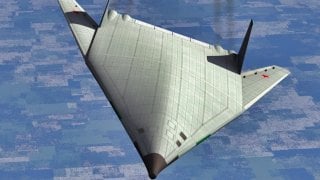PAK DA: Russia's New Bomber That Might Never 'Bomb' Anything
Tupolev, part of Russia’s United Aircraft Corporation, is developing the PAK DA, Russia’s first stealth bomber. Unlike traditional supersonic bombers, the subsonic PAK DA emphasizes stealth and low observability, akin to the U.S. B-2 Spirit.
What You Need to Know: Tupolev, part of Russia’s United Aircraft Corporation, is developing the PAK DA, Russia’s first stealth bomber. Unlike traditional supersonic bombers, the subsonic PAK DA emphasizes stealth and low observability, akin to the U.S. B-2 Spirit.
-Its flying wing design enhances radar evasion, while its internal weapons bay can accommodate a 30-ton payload, including nuclear and hypersonic missiles. Prototypes are expected by 2025, but Western sanctions and limited microchip access due to the Ukraine war raise doubts about its feasibility.
-Experts suggest financial and technological constraints may reduce the PAK DA to an aspirational project rather than a functional reality.
PAK DA: Russia’s Ambitious Stealth Bomber Faces Sanctions Hurdles
Russian aircraft designer Tupolev, now part of the United Aircraft Corporation - a powerhouse conglomerate that includes the likes of Sukhoi and Mikoyan-Gurevich - is well known for its large aircraft designs.
In the 1930’s, it held the record for the largest aircraft, the ANT-20 Maxim Gorky. Since then, the company has built on its pedigree with the Tu-95 strategic bomber, introduced in 1956 and still in service today; the Tu-154, one of the most ubiquitous short haul passenger jets in Russia and the former Eastern Bloc; and the Tu-144, the first ever supersonic commercial airliner.
Currently, Tupolev is working on their next project, the PAK DA, Russia’s first stealth bomber.
Introducing the PAK DA
The Russian Air Force has had a stealth bomber in the works for quite some time.
Initial requirements were formulated in the 1990s and by the first decade of the 2000’s, Tupolev had begun work on the design.
While for most combat aircraft, faster is better and aerospace engineers have worked to achieve that goal, in the case of the PAK DA, Tupolev has actually gone the other way and intends to produce a subsonic bomber incapable of flying faster than Mach 1.0.
Instead, the design focuses on stealth capabilities, seeking to produce a result similar to the U.S. Air Force’s B-2 Spirit bomber which relies on low observability rather than speed to survive.
B-2 Clone?
Stealth technology is not the only way the PAK DA appears to mimic the B-2. The Spirit is a highly recognizable aircraft due to its shape - it has often been called a flying wing. Essentially this means it does not have the typical parts of an aircraft, a fuselage, wings, and an empennage or tail assembly with various stabilization and flight control surfaces. Instead, the aircraft relies on a sophisticated flight control computer to maintain stability while aloft.
The lack of a tail assembly plays into the stealth aspect as well, greatly decreasing radar cross section.
Many details of the PAK DA remain unknown, however, its type of payload has been confirmed as conventional, nuclear, and even hypersonic weapons. Being able to launch such high speed ordnance is yet another reason which precludes the need for high speed flight.
Rather, being able to stealthily loiter outside an enemy’s air defenses while hypersonic missiles penetrate to the target will be the name of the game.
One of the challenges of stealth aircraft is weapons storage. Typically, combat aircraft store missiles, bombs, and rockets, on pylons or “racks” attached to the wings and fuselage. This both generates drag and reduces stealth profile making them easy to see.
To combat this, stealth aircraft are designed to store their weapons internally, which can make increasing the payload difficult. This doesn’t seem to be an issue for the PAK DA however, which is rumored to have a payload of 30T, more than the 20T limit of the B-2.
Currently, it appears that Tupolev has built at least one full scale mockup of the PAK DA and perhaps several smaller models for wind tunnel testing. Prototypes are expected to begin rolling out over the next several years and the first flight is projected for 2025.
While Russian Deputy Prime Minister Denis Maturov has said “there is no talk of using foreign parts in a project of this type,” it remains to be seen whether Western Sanctions due to the ongoing war in Ukraine will have an impact on the development of the new bomber.
What The Experts Told Us
"Clearly, Russia wants the PAK DA. However, I have no idea how they could afford it. Further, I would also add they don't have the microchips needed to make this work or technology due to sanctions related to the Ukraine war. For now, the PAK DA, I would argue, is just a dream," explained a former aviation expert who is retired from a major U.S. defense contractor.
Maya Carlin is an analyst with the Center for Security Policy and a former Anna Sobol Levy Fellow at IDC Herzliya in Israel. She has by-lines in many publications, including The National Interest, Jerusalem Post, and Times of Israel. You can follow her on Twitter: @MayaCarlin.
All images are Creative Commons.


